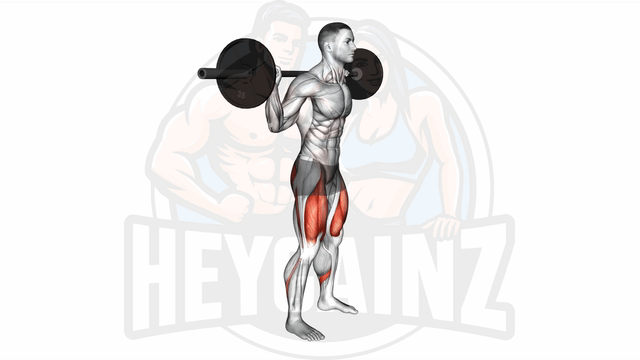
Instructions:
- 1Position the barbell on your lower traps
- 2Stand shoulder width apart and brace your core
- 3Begin the squat by bending your knees and sitting back
- 4Lower your body until your hips are below your knees
- 5Push back up to standing position
Tips:
- Keep your back straight throughout the movement
- Keep your knees over your toes
- Engage your core to maintain balance
- Drive upwards through your midfoot and heels
Barbell Low Bar Squat: A Comprehensive Guide
The barbell low bar squat is a popular lower body exercise that primarily targets the gluteus maximus and quadriceps. This squat variation is particularly favored by strength athletes and powerlifters for its effectiveness in building strength and muscle mass in the thighs and glutes.
Understanding the Barbell Low Bar Squat
Unlike the barbell high bar squat, where the bar is placed higher on the traps, the low bar squat involves positioning the barbell across the rear deltoids. This position allows for a more horizontal torso angle, resulting in greater engagement of the posterior chain while also distributing the load more effectively through the legs. The barbell medicine low bar squat and barbell low bar back squat are terms often used interchangeably in discussing this technique.
Benefits of the Barbell Low Bar Squat
- Improved muscle development in the thighs and glutes.
- Enhanced core stability and strength.
- Better performance in other lifts due to increased leg drive.
Tips for Proper Execution
To achieve optimal results and minimize the risk of injury, consider the following tips for performing the barbell low bar squat:
- Barbell Placement: Position the barbell lower on your back, resting just below the spine of your scapula.
- Foot Position: Feet should be shoulder-width apart with toes slightly pointed outward.
- Core Engagement: Keep your core tight to maintain stability throughout the movement.
- Depth of Squat: Aim to squat down until your thighs are parallel to the ground, or lower, while maintaining proper form.
Incorporating Variations
For those looking to diversify their training, variations like the barbell box back squat low bar or the barbell narrow high bar squat can provide different stimuli and challenges. Each variation emphasizes distinct aspects of muscle activation and can contribute to overall leg development.
Final Thoughts
Understanding the intricacies of the barbell low bar squat can greatly enhance your workout routine. By mastering this technique, you’ll see improvements not only in strength but also in overall athletic performance. Whether you're new to lifting or a seasoned athlete, incorporating the low bar squat into your regimen can lead to significant gains.